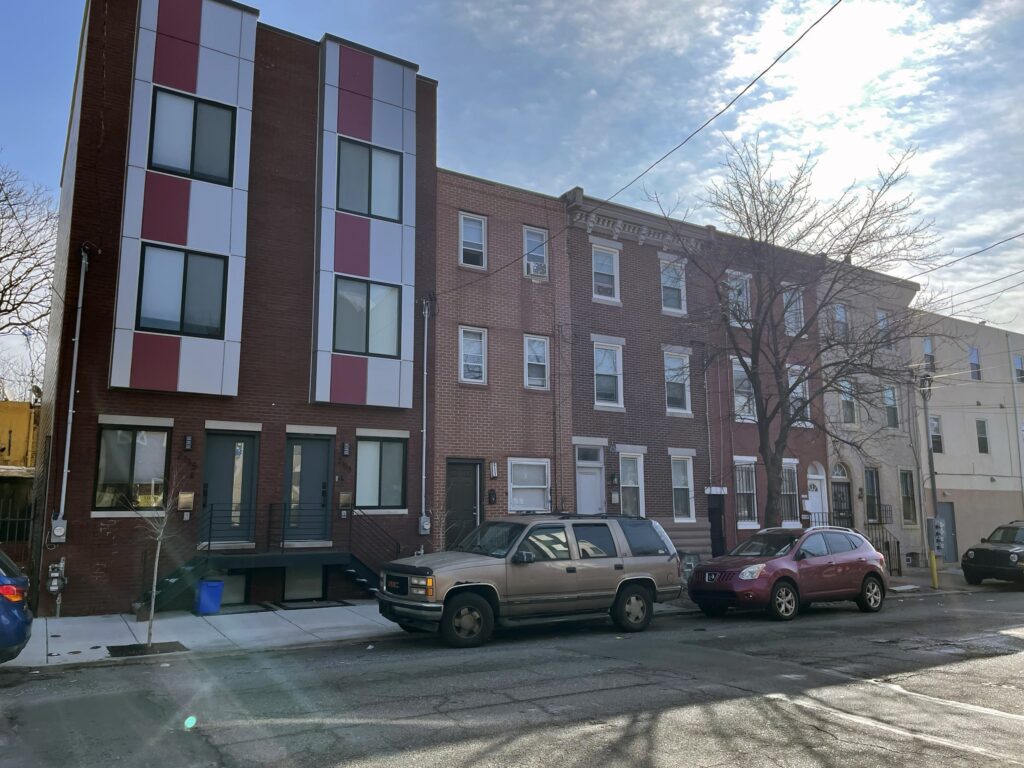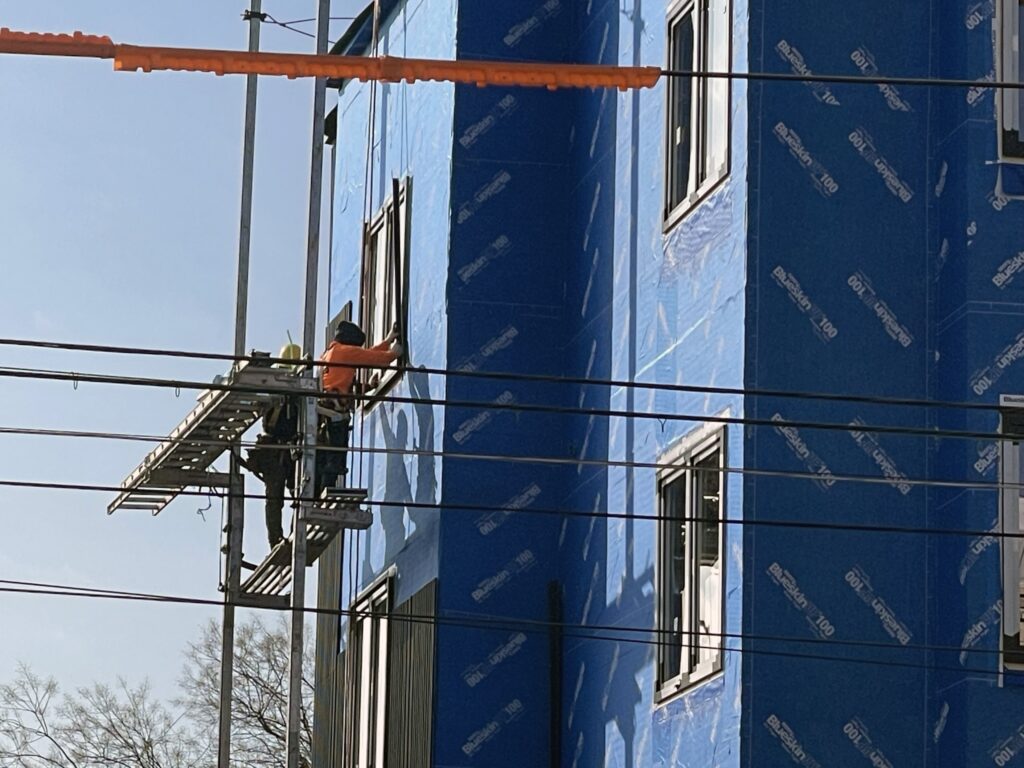Land Bank Board weighs private development proposal after community members express opposition
by Alayna Hutchinson
Norris Square is a neighborhood of contrasts.
There’s a strip of vacant land on American Street. It’s filled with overgrown weeds and littered with garbage. An abandoned trailer, old basketball hoop, and mattress sit among other pieces of trash. Behind the lot are well kept aging rowhomes with flowers, multi-use small buildings and swept sidewalks.
Across the street from the vacant lot are signs of what this once predominantly Puerto Rican working class neighborhood is becoming.
Welcome to “Fishtown West” and the brand new Luxe Apartments. According to Zillow, the complex has “unrivaled amenities,” including a two-story fitness center, sauna, golf simulator, coworking space, rooftop lounges, and units ranging from studios starting at $1,399 per month to three-bedrooms starting at $3,000.
Fishtown is known for its trendy restaurants, bars, cafes, and hipsters. Neighbors fear that world and the gentrification it brings, is creeping closer and closer to Norris Square, a Kensington neighborhood.

The area has become increasingly attractive to developers over the past several years, leading to skyrocketing housing prices. In the past 10 years, the market-rate for homes in the 19122 zip code has risen by more than 200 percent, with homes selling for around $400,000, and more than 120 percent in 19133 at close to $150,000, according to Redfin’s recent housing market data.
And more change could be coming.
The Philadelphia Land Bank has been considering a proposal for single-family, mixed-income housing by a private developer who was recently appointed to the Land Bank Board.

“How do you manage this kind of disruptive change? How do you hope to undo the damage if it’s not by saving the city lots that you have in your portfolio?” asked Nilda Pimentel-Perez, a resident and Chair of the Norris Square Community Action Network’s Resident Community Organization (RCO) in the September 12th Land Bank Board meeting. “We submit to you that it’s not by inviting real-estate developers to help dictate what a neighborhood will look like. That is a classic way of successfully gentrifying an area.”
Pimentel-Perez is among dozens of residents and several community organizations to voice opposition to the project, citing the need for deeply affordable housing for residents who are grappling with gentrification of the surrounding area over the last decade that’s seeping into Norris Square. Community leaders say residents have little say in the changes that are altering their lives and in some cases making their homes unaffordable.
BMK Properties, a Philadelphia-based design and home building firm under the Riverwards Group development company, has built dozens of multi and single-family homes throughout Fishtown, Northern Liberties, Port Richmond, and Kensington over the last decade. They have also built several workforce housing developments, which is what developer Mo Rushdy is aiming to do with this project. Buyers can design their own kitchen, in their beautiful new three-bedroom, three bath , energy efficient, “affordable” home.
He believes the community’s opposition is due to a “gap of information” and “ideological divides,” on how to bring affordable housing to the neighborhood.
But those opposed to the development want a voice in the future of neighborhood development. They don’t want to get priced out of their neighborhood.
“Community engagement cannot be a check box,” said Rafael Alverez Febo, Vice President for Advocacy and Community Development at Esperanza, during a testimony in the September 12th Land Bank Board meeting.
Project Proposal and Opposition
The Philadelphia Land Bank, which sits within the Philadelphia Housing Development Corporation (PHDC), manages a majority of the city’s publicly owned land. It’s governed by an independent board whose members are appointed by the Mayor and City Council president.
Individuals, businesses, developers, and community groups can apply to purchase land parcels from the agency for a variety of uses.
There are hundreds of vacant lots in and around Norris Square. Some longtime residents have cleaned up and maintained these lots for years, causing some community members to question the Land Bank’s priorities as developers look to acquire this land.
Patricia DeCarlo is co-chair of the Xiente Resident Community Organization (RCO), one of hundreds of RCOs in the city made up of community members concerned with development in their neighborhood. She said the Land Bank is partly responsible for this misalignment between the community and the proposal.
“I’m concerned as to what the Land Bank is doing, what it isn’t consulting in advance,” said DeCarlo. “You should have consulted this project with neighborhood plans. ‘What is it that you need? What is it that you want?’ Now that you know what we’d like to see, now go and negotiate. I think we need to go to the Land Bank and say we need some policy changes on how you’re doing things.”
In February 2023, BMK Properties submitted the project proposal to develop 75 vacant lots dotted throughout the Norris Square neighborhood into mixed-income single-family homes–37 market-rate units and 38 affordable units broken up into tiered income thresholds.

The proposal was met with significant pushback. Several community development corporations that focus on the Latino community have consistently submitted letters to the Land Bank opposing the disposition, including Asociación Puertorriqueños en Marcha (APM), Esperanza, and Xiente (formerly Norris Square Community Alliance) which included a petition signed by 51 residents calling for both a larger share of affordable housing, as well as lower income thresholds for the affordable housing units that reflect the reality of the community.
Manuel Delgado, Chief Operating Officer of Latino-based health, human services, community and economic development non-profit APM, said the community is overwhelmed with high-priced developments.
“The community has been saturated with significant market rate condos and single family market units and existing residents are being forced to relocate since opportunities for purchasing a home do not exist,” he said.
The Department of Housing and Urban Development sets income limits each year. They base it on their calculation of the Area Median Income (AMI). to determine renters’ and buyers’ eligibility for housing assistance programs.
In this case, the area’s median income is based on the sprawling Philadelphia metropolitan area which includes Pennsylvania, Delaware, New Jersey, and Maryland. The 2023 AMI for a family of four $114,400.

Norris Square’s median income ranges between $33,300 and $62,900, far below the AMI.

For this project proposal, BMK designated 17 units for families at 100 percent AMI, 13 units for 80 percent AMI, and eight for 60 percent AMI. That means that 17 units will be available to families making at or below $114,400, 13 for families making no more than $89,250, and eight for families making no more than $66,960.
“Neither of these ‘affordable’ options are affordable to our families that meet neighborhood median income, which means residents won’t benefit from the ‘affordable options’ being offered,” wrote DeCarlo in a letter to the Land Bank board in October 2023.
District 7 Councilmember Quetcy Lozada has sided with community members and organizations in their opposition.
“Considering that presently the only viable housing options available in the Norris Square area are at rent levels that the average resident cannot afford, coupled with the fact that no new housing project targeted to low-and-moderate-income residents is in the works in the foreseeable future, makes the use of the public lots for the BMK project not appropriate at this particular time,” wrote Lozada in a letter to the Land Bank Board in October 2023.
A number of residents and community leaders voiced their opposition in the Land Bank’s September and October board meetings, resulting in frustration from both the community and BMK on the board’s handling of the proposal.
In the October meeting, BMK agreed to work with the neighbors and hold another community meeting. The final outcome is yet to be determined.
A CHANGING NEIGHBORHOOD
Ana Santos moved to Norris Square in the 1950s along with many other Puerto Rican families looking for better economic opportunities.
But over 50 years later, Santos’ community is becoming unaffordable.
In the past year, she said her property taxes have more than doubled as tax increases hit Norris Square hard after the city’s latest property assessment in 2022.
“And of course the city wasn’t doing anything for anybody. They let everything go down like they do,” Santos said. “We’re used to it, you know. Now everything changes because the white folks have moved in.”
“I don’t even know half the people on my block.”

From 2010 to 2020, according to the U.S. Census, the non-Hispanic or Latino white population grew by more than 50 percent in 19133 and 62 percent in 19122, while the Hispanic or Latino population fell by six percent in 19133 and nine percent in 19122.
As property values have increased in the neighborhood, rent prices have also soared. From 2011 to 2021, according to the U.S. Census American Community Survey five-year estimates, the median rent went up between 45 and 48 percent in both ZIP codes–$1,091 in 19122 and $906 in 19133 as of 2022. Nearly 60 percent of households in both ZIP codes spent more than 30 percent of their income on rent, meaning they are classified as rent-burdened by the Census Bureau.
Renters face the greatest risk of displacement when housing costs rise, and with more than half of households renting, Norris Square residents have started to experience the effects. Data from the Princeton Eviction Lab shows that in 2023, parts of the neighborhood have seen between 59 and 138 percent more eviction filings than the average rate for the entire city.
“Currently we know many families living with relatives in doubled-up conditions,” said Talia Giles, the director of Philly Liberation Center in Norris Square, during a testimony in the Sept. 12 Land Bank Board meeting. “Although these are anecdotal accounts, we are seeing how this situation is becoming more widespread across the neighborhood, pointing to an emerging crisis. These are individuals with very little disposable income and few savings to afford purchasing a house.”
Dr. Michelle Carrera-Morales, Executive Director of the Norris Square nonprofit Xiente, whose mission is to disrupt intergenerational poverty, described the effects of gentrification on the predominantly Latino community in a letter to the Land Bank Board in September.
“These are families who have lived in these communities for over 40 years and fought to reverse the image that the Norris Square community had in the early 80s, dubbed ‘the Bad Lands,’” she said. “Not only has our community had to deal with the drug epidemic, crime, lack of city resources, gentrification, rocketing real-estate taxes, and property damages from adjacent property construction, they now face the rise of losing their homes.”
Greg Hackett, who works at a local gym, said he’s seen how it’s changed from the time he used to go to the Cousin’s Supermarket in the area when he was young. He said there has been an influx of college students in the area and that change is just what happens in a city neighborhood.
“It has to happen. It comes with change, it comes with time,” Hackett said. “You can’t really stop it, and then sometimes I don’t think it’s worth it to stop it.”
AN OPPORTUNITY TO BUILD WORKFORCE HOUSING
BMK Properties developer Rushdy, said that addressing the need for affordable housing requires private developers. He said that nonprofits “want to be developers,” but lack the funding necessary to build homes at scale, explaining that they have a valuable role, but should focus on providing housing counseling and other resources to qualified buyers.
“If you’re serious about solving the affordable housing crisis, you have to realize that the only way to do it is to bring the private sector into building affordable housing,” Rushdy said.

He emphasized that, by leveraging profits, only private developers can build housing necessary to address the city’s affordable housing shortage.
The affordable units in the proposal would be eligible for PHDC’s Turn the Key program, which helps income-eligible first-time buyers purchase homes in the city, giving preference to Philadelphia municipal employees. Rushdy believes this project would provide low to moderate-income city workers the ability to purchase homes and build generational wealth.
He also noted the large number of city job vacancies, which some have attributed to the requirement for employees to live within city limits, and believes that providing city employees with homeownership opportunities in Philadelphia could help address that.
“We can create a lot of opportunity using this program if we get out of our own way,” Rushdy said. “We’re continuously fighting ourselves.”
However, Councilmember Lozada and some community organizations have pushed back on workforce housing, pointing out that the residents most in need of housing are not city workers.
“The disposing of 75 parcels of city-owned property may serve a short-term goal of creating housing opportunities for our workforce, but I must ensure, as the people’s representative of the 7th Council district, that my entire constituency has viable housing options and opportunities,” wrote Councilmember Lozada in a letter to the Land Bank Board in October 2023.
FRUSTRATION OVER COMMUNITY ENGAGEMENT
Rushdy held two separate Zoom meetings with the Norris Square Community Action Network and Xiente RCOs in the summer, but some residents claimed that there were several barriers to participation.
“Community engagement has been deficient in the discussion of this disposition,” wrote Will Gonzalez, Executive Director of Ceiba, a nonprofit in Norris Square that focuses on economic development and financial inclusion for the Latino community, in a letter to the Land Bank Board in September 2023. “It took place in English and there was no Spanish language interpreter. Less than 10 community members participated.”
Community members will weigh in on the alternative proposal that Rushdy and the Board decide on during a follow-up meeting, which is required by the Land Bank to have Spanish translation, and will take place in early 2024.
Logan Center Data Reporter Abdullah Pullin contributed to this report.


